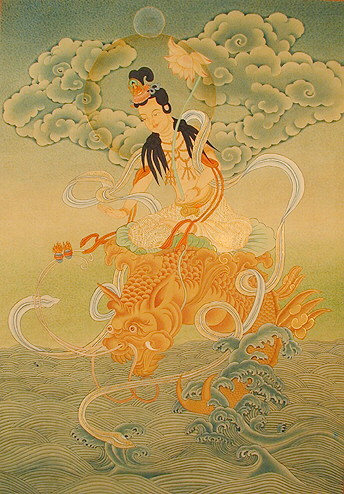
Kuan-Yin, Mother of Mercy
Introduction
Like the European mother of gods, whose worship as Mary, star of the sea, continues
to this day against great institutional and theological odds, the great goddess
of China survived the Buddhization of her realm by becoming Kuan Yin, mother
of mercy. Often associated with the waters of the deep, perhaps riding a dolphin
or a fish, Kuan Yin probably originated in the ancient Nu Kua, the great ocean-snail
snake dragon woman who gave birth to all the life and the patterns of the universe.
Kuan means earth, and yin is the feminine balance to yang, both of which exist
at the root of all the beings and workings of the world. Yin is a state and
an energy that flows, creating gentle, consistent, and determined action.
In the Land of the Dead
The goddess Kuan Yin longed to live among humans. Living so, she would understand
the joys and sorrows of mortal life and increase her wisdom when humans called
on her for help.
So one day Kuan Yin came to live as the youngest daughter of three in a house
with a cruel father. When he didn't ignore his daughters, he spoke coldly to
them. When they came of age, he raged. "I'm tired of you. Find yourselves
husbands. Stay in their houses, not mine. You are not welcome here."
The eldest daughter married a silent warrior. The second wed a greedy merchant.
But Kuan Yin said, "I do not wish to marry. I am going to live in the temple
of the white bird with the lotus flowers in its fountain."
Kuan Yin went to live in the temple of the white bird with its roof of gold
and black. When she continued to refuse to marry, her father arranged for the
women in the temple to treat Kuan Yin harshly. "Make her do all the hardest
work," he ordered. "Pull her hair. Give her only dry bread and water
to eat. Then she will leave the temple and marry, as I command."
Some women at the temple were afraid, and they obeyed Kuan Yin's father. They
gave her too much work and too little food. But, under the willow tree, Kuan
Yin pretended to sleep, waiting until all the others slept. Then the green serpent
came to help her carry the water. The white tiger appeared and gathered wood
for the fire. The wrens busily collected vegetables from the garden. The spirit
of the fire rose up and helped to cook the food. The peacock swept the kitchen
floor with this thousand-eyed tail.
When Kuan Yin's father heard of the animals' help, he set fire to the temple.
"Who dares defy me will die!" he roared.
But Kuan Yin put out the fire with her own hands and a branch from the willow
tree. When her father saw that not only was the temple safe, but that the branch
was not burnt, nor Kuan Yin's hands even blistered, his rage knew no bounds.
"Find her and cut off her head!" he ordered his servant.
The servant's sword, unable to harm the body of Kuan Yin, broke itself in two.
But the servant, afraid to fail in the task of killing Kuan Yin, squeezed her
throat with his hands until she could not longer breathe. Then he tied her lifeless
body to the back of a yellow tiger, setting it loose in the jungle.
The land of the dead was dark, and Kuan Yin was afraid. But soon she sat up
and began to sing. You know the songs she sang. The ones with the melodies that
comfort and bring the sleep of renewal. The people who lived in the land of
the dead gathered around Kuan Yin. They looked in wonder at her gentle face,
and began to take each other's hands. They touched her soft robes, and began
to chant and hum. Pain and loneliness melted into peace and joy.
The king of the dead was furious. "No singing in this place!" he thundered.
"Begone!" And he banished Kuan Yin from the kingdom of death.
So Kuan Yin returned to earth and joined again her soul with her body. Floating
and flying, she made her way to an island in the north-eastern sea. There she
lives to this day, chanting and singing for the well-being of all in the land
of the living and the land of the dead. There, she puts out our fires with her
sacred willow branch and mercifully comforts us whenever we call our her name.